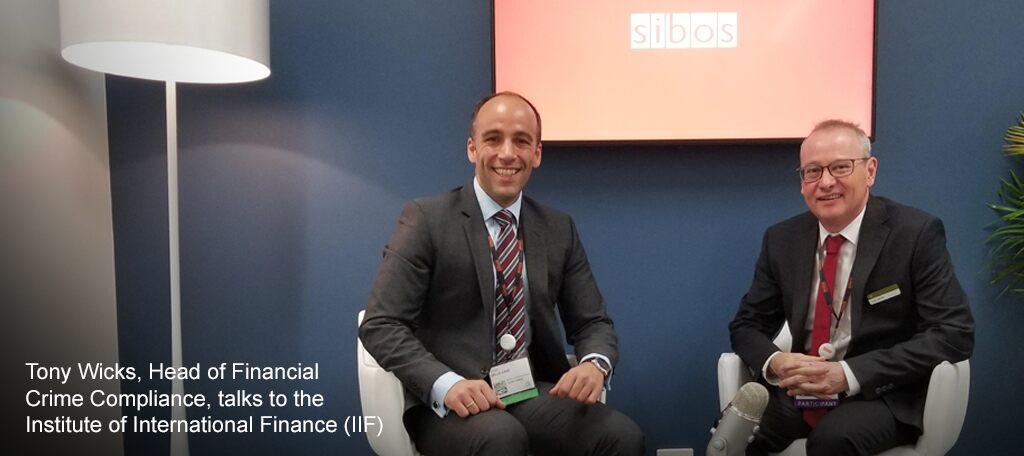Combatting financial crime
Listen to this recent FRT (Finance, Regulation and Tech Innovation) podcast, live from Sibos, Sydney, to learn more about the role of innovation in Anti-Money Laundering.
Innovation in financial crime compliance is often a means of solving a very specific business problem, and data analytics tools can help. It’s also about addressing business problems at the right time and then applying the right technology. Leveraging technology to increase the efficiency of compliance processes can help to promote business, as it becomes more profitable and manageable from a risk perspective.
And will compliance continue to be an area of competition as we move towards an information sharing framework similar to the KYC utilities?
Read the highlights below, or listen to the full interview.

IIF: How is Swift involved in preventing financial crime? Isn’t this the responsibility of its users?
Tony Wicks: Absolutely, this responsibility sits with the users themselves. Swift is essentially a messaging provider. Like the post office, we deliver messages from one institution to another and are the gateway that roots the key or critical payment information. We provide them with tools to help them take on their compliance burden. And our aim is to create financial crime compliance solutions that work for all institutions in our community – large or small.
IIF: The theme of this year’s Sibos is ‘Enabling the digital economy’. Which areas of financial crime compliance can benefit from digital innovation?
TW: Digital innovation is everywhere, including new approaches to innovation for payments, which we can apply to compliance: blockchain, crypto currencies, AI and RegTech. But the technology itself is not as interesting as the potential of the business problems we need to solve. Swift is creating solutions that respond to the needs of our community, some of which use or apply innovative methods. And the value here is associated with business process and how this benefits the community.
The technology itself is not as interesting as the potential of the business problems we need to solve.
The KYC Registry is a great example. 5000 institutions are now standardising the way they collaborate and exchange correspondent due diligence information. It provides a global standard, supported by the Wolfsberg Due Diligence Questionnaire. And we are doing similar things in other areas, such as Sanctions Screening.
Compliance Analytics provides users with insights into data they are sending across Swift, and we have just launched our first fraud solution - Payment Controls.
IIF: Innovation in banking products focuses on finding new ways to bring products to market. In the RegTech space, are you focusing on existing challenges and how you can add value?
TW: We’re interested in new technologies, but digital innovation can be more about timing. Innovation is not always about applying a brand new technique; it’s about applying the technique at the right time.
Our community needs tools and technologies to help deal with compliance costs. People are also concerned with the quality and outcomes associated with compliance processes. Regulators are still taking a fairly tick-box approach. But we see that the SAR rates are going up each year and 80-90% of these fail to go on to criminal investigation or receipt of funds. These kinds of statistics mean that we all need to do better in terms of outcomes – something everyone is focusing on.
And finally, regulatory focus continues to be on process rather than outcome – meaning compliance expectations don’t bear the right relationship to the goal of preventing financial crime. So these issues are driving us towards cost reduction and improved outcomes, and looking at new analytical methods that could potentially catch the ‘bad guys’ to make a real difference.
IIF: We often hear that compliance innovation projects are not a priority, as profits are not immediate. What would you make of that statement?
TW: At a macro level, across the financial services industry, the view is that financial crime compliance is a non-competitive area - with no financial benefit to doing it better than others. It’s a different story at the micro level, where the perception is the reverse; reducing compliance costs and increasing efficiency, whilst maintaining the same level of outcomes, allows you to take on business that you would otherwise have turned down due to the associated compliance costs.
IIF: So compliance acts as a business enabler in that context. And would the correspondent banking discussion fit in at this point if we were able to streamline the existing due diligence processes between correspondent banks?
TW: Over the last five years, we have seen a wave of economic de-risking associated with correspondent cross-border relationships. We know that it is safer and better for money to move through legitimate transfer means and a legitimate network that is compliant with regulation and law. Swift is about secure, compliant payments – we’re interested in making sure they are compliant across our network and that the people sending payments step up to their full responsibility. Swift is helping institutions of all sizes to meet their compliance obligations and maintain business relationships.
IIF: How is Swift’s KYC Registry going to evolve? Are we looking at hurdles from a regulatory standpoint?
TW: Swift is driving the notion of utilities in relation to financial crime compliance. This is because we are a cooperative and believe that at a macro level compliance is non-competitive. A utility allows us to provide a quality solution to institutions at a price point that makes sense. And we are introducing tools and technologies based on the requirements of our community.
We can be more agile with those platforms than potentially any other single institution can be in terms of making changes or updates. We can benefit more from the new technologies, such as robotic process automation, the use of machine learning to understand behaviours – and we can then apply them for use by everyone connected to that utility.
A key point is that fraudsters collaborate incredibly well and know that, as an industry, we should collaborate more openly.
A key point is that fraudsters collaborate incredibly well and know that, as an industry, we should collaborate more openly. A utility model allows us to provide a consortium for information exchange - the potential is exciting and the utility model is one that will see huge emergence in terms of new ideas.


